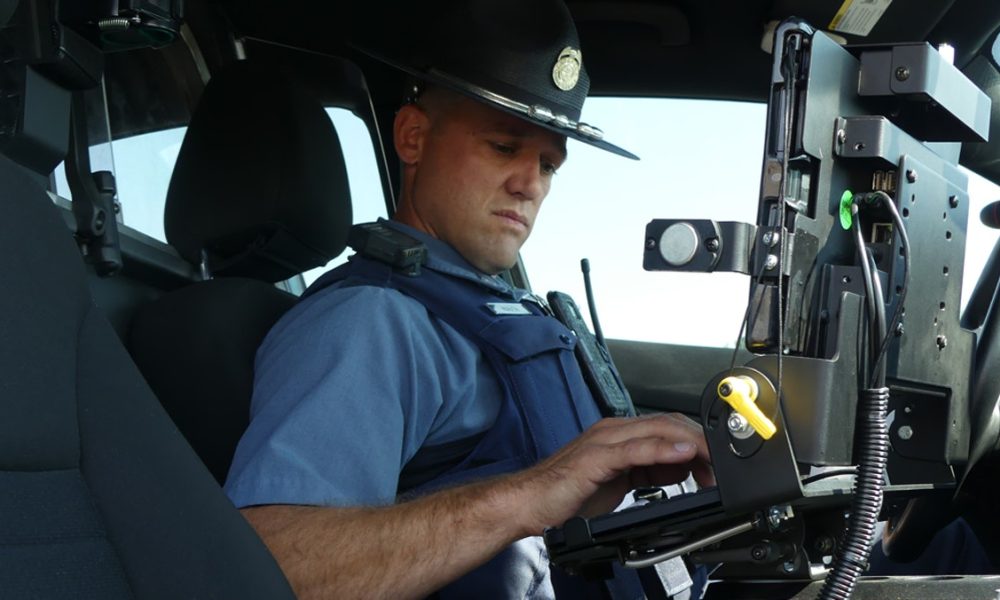 Oregon State Police Sgt. Kurt Marvin logs in information about a driver for exceeding the speed limit. The OSP wants to remind drivers to slow down and be aware out on the road as the best way to cut down on deadly crashes. (The Enterprise/Pat Caldwell)
Oregon State Police Sgt. Kurt Marvin logs in information about a driver for exceeding the speed limit. The OSP wants to remind drivers to slow down and be aware out on the road as the best way to cut down on deadly crashes. (The Enterprise/Pat Caldwell)
ONTARIO – Just before noon on the last day of Labor Day weekend, Oregon State Police Lt. Mark Duncan was busier than expected on Interstate 84.
Duncan, the Ontario OSP station commander, knew the interstate would be crowded on a holiday weekend, but the amount of traffic and the high speeds surprised the 20-year OSP veteran.
Duncan issued his first speeding ticket for 90 mph. In quick succession after that, he wrote tickets to drivers going 89, 93 and 96 mph.
“It was a very heavy volume of traffic at very high speeds,” said Duncan. Two things kill drivers: lots of traffic and high speed. Duncan and his troopers have spent enough time on the interstate and local roadways to know that maxim is true but the message apparently isn’t sinking in with the public. Duncan thinks he knows why.
“We have a humongous issue with ‘It won’t happen to me’ syndrome,” said Duncan. “Motorists will see a horrifying catastrophe and say ‘Oh, it won’t happen to me.’”
But it does happen and statistics from OSP show more fatal crashes happened across the state this August than last year.
In August 2017, OSP reported 34 traffic fatalities across the state. This year, the total was 43.
“That’s huge. That is a 65 percent increase,” said Duncan.
So far for 2018, state officials logged 304 traffic fatalities compared to 274 over the same time period last year.
That is a 13 percent jump, something Duncan said is “alarmingly high.”
“It is an absolute horrible number to see,” said Duncan.
The trend holds true for the Ontario region, too.
From January 2016 to the end of 2017, Duncan said his office recorded three deaths from local crashes. So far in 2018, seven people died on local roadways.
Two questions linger regarding the recent rise in the number of fatal crashes on Oregon roadways: Why are they happening and how can they be decreased?
The why is harder to define than the how, said OSP Sgt. Kurt Marvin.
Duncan said all crashes in Oregon can be attributed to what the state police call the “fatal five” – driving under the influence, excessive speed, lane departures, not wearing a seatbelt and distracted driving.
Robin Ness, manager of the crash analysis and reporting for the state Highway Division said highway fatalities tend to fluctuate.
“There are so many factors that influence the number of fatal traffic crashes which vary from driver, pedestrian and bicyclist’s good and bad behavioral elements. This year it seems there has been a larger number of multiple fatality crashes than last year,” said Ness.
One of the state’s most deadly crashes occurred last month south of Crane when eight people, including five children, died in a head-on collision.
Ness said traffic volume and weather can also play a role in fatal crashes.
Ness said speed and distracted driving are common causes.
“Highways haven’t changed. But with technology there are more and more distractions such as cell phones,” said Marvin.
Duncan and Marvin said cell phones remain one of the biggest contributors to crashes.
Marvin said he recently pulled a driver over who was texting with both hands over the steering wheel.
“Distracted driving has always been here, we know that. But now you have more drivers, more distractions and society in general is in a hurry. It’s a recipe for disaster,” said Marvin.
A recent traffic enforcement operation by the Nyssa Police Department netted 29 citations, including six for cell phone use while driving.
Duncan and Marvin said the steps to reduce highway fatalities are simple but also seemingly difficult for the motoring public to do.
“It’s staying off the phone. Increasing your following distance, reducing your speed and using your seatbelt,” said Duncan. More police patrols can deter bad behavior too.
A repaving project on U.S. Highway 95 pushed more traffic onto Oregon Highway 201. More crashes soon followed so Duncan ordered extra patrols.
“We wrote quite a few tickets and it eliminated the crashes,” said Marvin.
With 11 troopers assigned to the Ontario command, such saturation efforts are short-lived, said Duncan.
“It just kicks the can down the road. If we load up on (Oregon Highway) 201 we are neglecting U.S. Highway 20 or Highway 95 or the interstate,” said Duncan.
That’s because the OSP office must assign troopers over a county bigger than the state of Delaware.
“The Ontario command has the largest patrol area in the state,” said Duncan. The station is responsible for 9,930 square miles.
“We just have to be vigilant as law enforcement. Not only have a heavy presence but provide education,” said Duncan.
“We have to educate our motorists and youth about how it affects families and even affects schools. You lose a young driver to texting or talking on a cell phone and that person could be in involved in scholastic sports or FFA,” said Duncan.
Reporter Pat Caldwell: [email protected] or 541-473-3377.




